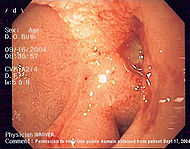
Forrest classification
Encyclopedia
Forrest classification is a classification of upper gastrointestinal hemorrhage used for purposes of comparison and in selecting patients for endoscopic treatment
 Acute hemorrhage
Acute hemorrhage
Signs of recent hemorrhage
Lesions without active bleeding
. It is also a significant method of prediction of the risk of rebleeding and very often is used for evaluation of the
endoscopic intervention modalities. A prospective controlled study carried out by Dr. Walter Heldwein, J. Schreiner, José Pedrazzoli Júnior, P.Lehnhert at Medizinische Klinik Innenstadt der Universität München revealed that "Forrest criteria are essential for proper planning of endoscopic therapy and urgent surgery in bleeding peptic ulcers".
Forrest classification

- Forrest I a (Spurting hemorrhage)
- Forrest I b (Oozing hemorrhage)
Signs of recent hemorrhage
- Forrest II a (Visible vessel)
- Forrest II b (Adherent clot)
- Forrest II c (Hematin on ulcerPeptic ulcerA peptic ulcer, also known as PUD or peptic ulcer disease, is the most common ulcer of an area of the gastrointestinal tract that is usually acidic and thus extremely painful. It is defined as mucosal erosions equal to or greater than 0.5 cm...
base)
Lesions without active bleeding
- Forrest III (Lesions without signs of recent hemorrhage)
Application
Forrest classification is instrumental when stratifying patients with upper gastrointestinal hemorrhage into high and low risk categories for mortalityMortality rate
Mortality rate is a measure of the number of deaths in a population, scaled to the size of that population, per unit time...
. It is also a significant method of prediction of the risk of rebleeding and very often is used for evaluation of the
endoscopic intervention modalities. A prospective controlled study carried out by Dr. Walter Heldwein, J. Schreiner, José Pedrazzoli Júnior, P.Lehnhert at Medizinische Klinik Innenstadt der Universität München revealed that "Forrest criteria are essential for proper planning of endoscopic therapy and urgent surgery in bleeding peptic ulcers".

